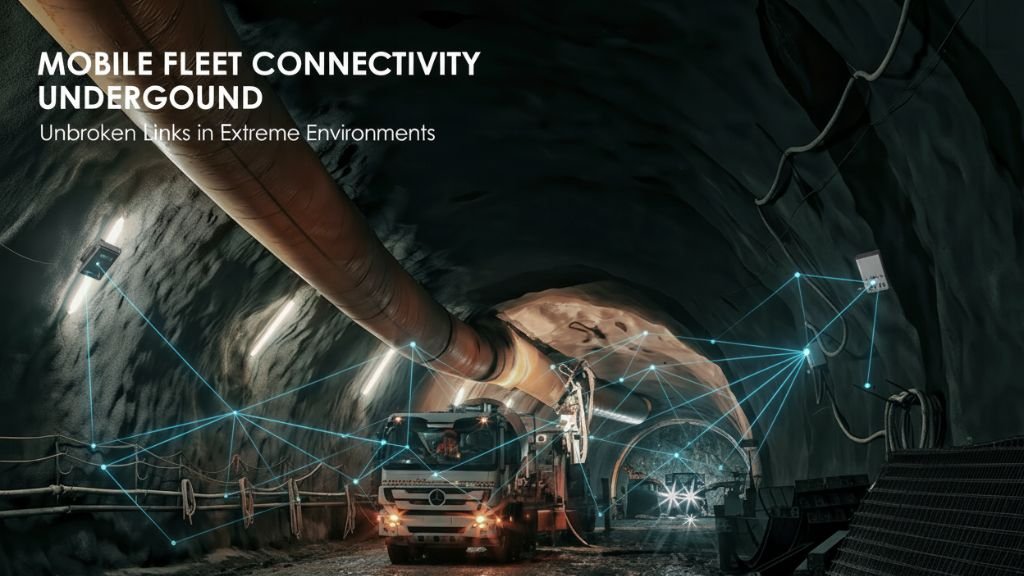In today’s connected world, mobility is everything. Whether it’s a mining truck deep underground, an emergency response vehicle rushing through city streets, or a logistics fleet spread across hundreds of kilometers — real-time communication is essential. The challenge? Traditional wireless systems often fail when vehicles move across wide or rugged areas, leading to connectivity drops, data delays, and safety risks.
That’s where wireless mesh networks are changing the game. Built for mobility, flexibility, and resilience, they provide the high-speed, always-on communication that modern fleet operations demand.
The Connectivity Challenge for Mobile Fleets
Most fleet-based industries rely on continuous data — GPS tracking, live video feeds, and sensor updates. However, cellular networks or point-to-point radio links are not designed for the constant movement of vehicles across variable terrain.
When a truck or vehicle moves beyond the coverage zone of a cell tower or a single radio node, communication can break down instantly. In mining sites, ports, and large industrial zones, this means lost productivity, delayed decision-making, and increased operational risks.
What’s needed is a network that moves with the fleet, maintaining consistent performance no matter where each vehicle travels.
Wireless Mesh Networks: Designed for Mobility
Unlike traditional systems that rely on a central hub, a wireless mesh network forms a web of interconnected nodes. Each node communicates with others, dynamically routing data through the most efficient path.
This architecture provides three major advantages for mobile fleets:
-
Self-Healing Connectivity – If one node goes offline, the system automatically reroutes data through alternate nodes, preventing downtime.
-
High-Speed Roaming – Vehicles equipped with wireless mesh network systems can move freely across large areas while maintaining strong, low-latency connections.
-
Scalable Deployment – Adding new vehicles or expanding coverage areas requires minimal setup. Each new node simply becomes part of the existing network.
This flexibility makes wireless mesh networks a preferred choice for industrial fleets, mining operations, smart cities, and public safety agencies.
Real-Time Data Means Smarter Decisions
For industries that depend on mobility, real-time visibility is power. Mesh networks enable continuous streams of data — from vehicle diagnostics to live video monitoring — all without delay.
Fleet managers can:
-
Track vehicle location and performance in real time.
-
Receive instant alerts during equipment failures or emergencies.
-
Monitor fuel usage, route efficiency, and operational safety.
By keeping vehicles and control centers connected at all times, wireless mesh networks enhance productivity and enable smarter, faster decision-making.
Built to Withstand Harsh Environments
Industrial and field fleets don’t operate in ideal conditions. They face dust, vibrations, moisture, and extreme temperatures. That’s why robust connectivity equipment is critical.
Modern solutions like the MWS-2400 high-performance mesh system are designed to perform reliably in rugged terrains and moving environments. With multi-radio configurations and low-latency data handling, they ensure smooth communication even in challenging conditions.
Whether it’s mining operations, large industrial plants, or mobile command vehicles, mesh technology ensures dependable connectivity — where failure is not an option.
The Future of Fleet Communication
Wireless mesh networks are not just a replacement for old systems — they represent the future of industrial communication. As fleets become more automated and data-driven, the need for seamless, mobile, and high-speed networks will only grow.
From self-driving mining trucks to real-time logistics tracking, mesh connectivity is paving the way for the next generation of intelligent, connected operations.
With improved range, capacity, and adaptability, these networks are redefining what’s possible in industrial mobility — keeping teams connected, informed, and in control.
FAQs
1. What makes wireless mesh networks ideal for mobile fleet communication?
Wireless mesh networks provide decentralized connectivity, allowing vehicles to maintain strong communication links even while moving. They automatically reroute data between nodes, ensuring zero downtime and high reliability in dynamic environments
2. Can wireless mesh systems work in harsh industrial conditions?
Yes. Industrial-grade mesh products are built to withstand heat, dust, vibration, and other extreme conditions. They’re perfect for applications in mining, manufacturing, and logistics where stable connectivity is crucial.
3. How do mesh networks improve safety and efficiency for fleets?
By enabling real-time monitoring, two-way communication, and instant alerts, mesh networks help fleet managers respond quickly to any issue. This boosts operational safety, reduces downtime, and improves decision-making efficiency.
